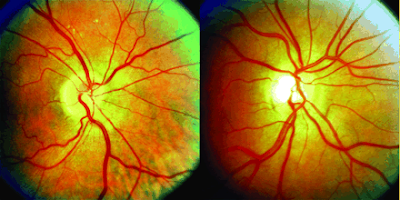 |
|
Digital photograph of narrow retinal arteries (left) compared to normal
retinal arteries (right) (Source: http://www.bmj.com/content/329/7457/79)
|
The findings from the Australian Blue Mountains Eye Study,
conducted by researchers at the University of Sydney, were published in
Ophthalmology, the journal of the American Academy of Ophthalmology.
Here’s a list of the main risk factors, including its
newest, found for glaucoma:
- Age: Those that are over the age of 40 are more likely to develop glaucoma. The older you are, the greater your risk.
- Race: African-Americans are more likely to get glaucoma than the rest of the population. They also develop glaucoma at a younger age; on average, about 10 years earlier than any other race.
- Family History: If you have a parent or sibling who has glaucoma, you are more likely to develop the disease.
- Diabetes: People with diabetes have a 40% higher risk of developing glaucoma.
- Nearsightedness: People who are very nearsighted are at greater risk.
- Eye Injury or Surgery: Those who have had eye surgery or eye injuries may develop secondary glaucoma.
- Steroid Medication: Steroids may increase the risk of glaucoma when used for extended periods of time.
- Narrow Retinal Arteries: People with abnormally narrow retinal arteries are more likely to develop glaucoma.
Glaucoma doesn’t show any symptoms,
but rather slowly steals your vision (hence it being nicknamed “the sneak thief
of sight”) and before you know it, you could be completely blind. Knowing the
risks and getting regular comprehensive eye exams is extremely important because
if glaucoma is detected early, you may be able to save your sight.

No comments:
Post a Comment